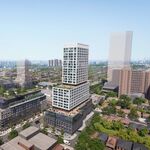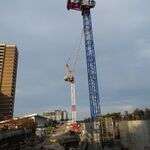Undercutting removes the ballast and a bit of subgrade from under the track, leaving the rails and crossties intact. Basically a big creeping machine with an arm with devices that reach under the track, scoop out the ballast and dirt, and dump it to the side or into a ballast cleaner.
After undercutting, the subgrade can be repaired and improved, by either adding new granular material, and/or adding geotextile. Then ballast - either new and/cleaned old material - iis dumped on top. Last, the line is tamped, which moves some of the ballast under the track, bringing the tracks up to the original level, (or to a new elevation in some cases). After plenty of tamping, the new grading or banking is achieved.
The Guelph Sub had very old and muddy ballast, even sections of cinder ballast dating from the steam engine era. This work upgrades the track bed to handle today’s heavier trains and to achieve a surface that will support higher speeds. It’s a pretty significant improvement towards a RER quality track after decades of minimal maintenance of a fundamentally steam-era roadbed.
- Paul




